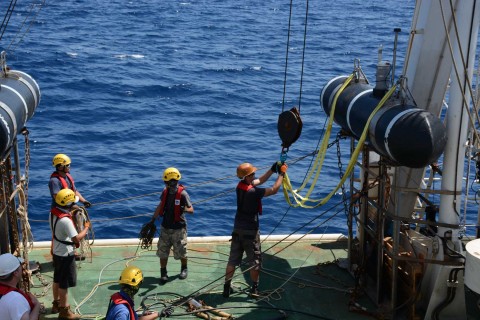We finished to collect the 2D seismic lines this morning and deployed the P-Cable system early afternoon. Below are some pictures of the deployment.
Nous avons terminé l’acquisition des données 2D ce matin et avons déployé le dispositif P-Cable tôt dans l’après-midi. Ci-dessous, quelques photos du déploiement.
You might probably be interested knowing why I’m still adding pictures of the deployment since I’ve already shown you some previously? I will simply tell you that I’m really fascinated by it especially when the paravanes are deployed. Imagine, 1 ton each deployed into the water! This requires assistance of a crane as well as organisation and concentration from the people working on the deck especially when they’re getting close to the edge of the deck!
Vous vous demandez probablement pourquoi je continue de mettre des illustrations du déploiement puisque j’en ai déjà posté précédemment ? Je vous répondrai simplement que je trouve le déploiement du dispositif P-Cable fascinant; tout particulièrement le déploiement des paravents. Imaginez, 1 tonne chaque à déplacer et mettre à l’eau ! Cela nécessite l’utilisation d’une grue et demande de l’organisation ainsi que de la concentration venant de la part des personnes travaillant sur le pont au cours de l’opération puisque ces derniers se trouvent , la plupart du temps, très proche du bord !
So, we started to record 3D data today but hardly in the middle of the first line that a problem occurred with the data cable and we had to take the decision of bringing back the port paravane close to the deck in order to check the cable connection. Below are some pictures of the operation.
Nous avons donc commencé à acquérir des données 3D aujourd’hui mais à peine arrivés au milieu du premier profil qu’un problème est apparu au niveau du câble des données. Nous avons donc décidé de ramener le paravent de bâbord proche du bateau afin de vérifier la connexion du câble. Ci-dessous, quelques photos de l’opération.

Bringing the port paravane close to the desk to check the data cable connection. Paravent à bâbord ramené proche du pont arrière pour vérifier la connexion du câble des données. Photo: Elodie Lebas

Bringing the port paravane close to the desk to check the data cable connection. Paravent à bâbord ramené proche du pont arrière pour vérifier la connexion du câble des données. Photo: Elodie Lebas

Bringing the port paravane close to the desk to check the data cable connection. Paravent à bâbord ramené proche du pont arrière pour vérifier la connexion du câble des données. Photo: Elodie Lebas

Bringing the port paravane close to the desk to check the data cable connection. Paravent à bâbord ramené proche du pont arrière pour vérifier la connexion du câble des données. Photo: Elodie Lebas

Bringing the port paravane close to the desk to check the data cable connection. Paravent à bâbord ramené proche du pont arrière pour vérifier la connexion du câble des données. Photo: Elodie Lebas










